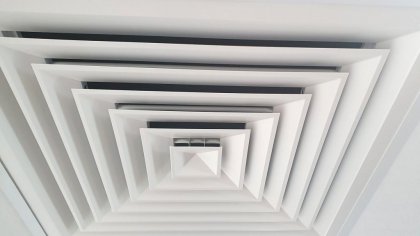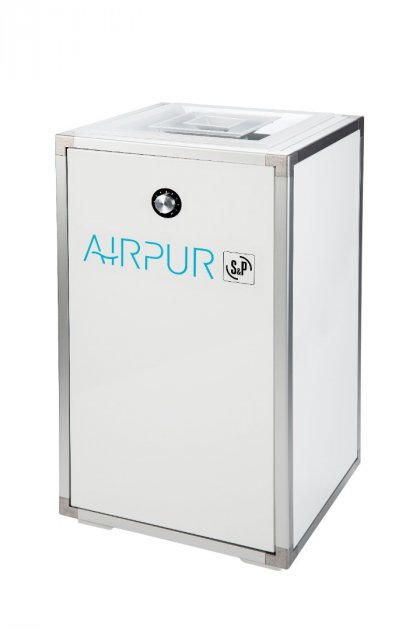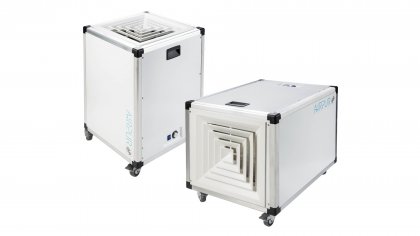Adequate room air exchange significantly reduces the risk of transmission of covid-19. However, natural ventilation has its limits. So what is the recommended solution?
Natural ventilation and possible pitfalls of its use
Effective ventilation is, as almost all experts agree, one of the reliable, well-functioning and at the same time essentially simple tools against the spread of SARS-CoV-2, the virus that causes covid-19 disease. However, it is not always possible to provide effective ventilation of spaces in a natural way by means of openable building openings such as windows or doors.
There may be several reasons why natural ventilation is not always possible. In some cases, these are hygienic reasons. If the building to be ventilated is located near a busy road, then the interior spaces are subject to pollutants from the outside (e.g. dust, traffic exhaust fumes) and excessive noise when naturally ventilated.
The use of natural ventilation is also very problematic during the cold season of the year. The reason is obvious. Ventilation with cold outside air leads to unwanted cooling of rooms and the appearance of cold air currents. This causes a feeling of thermal discomfort for the occupants of the ventilated rooms. Another not insignificant negative factor is the need to ensure that the increased heat loss is covered by ventilation, which increases the operating costs of energy.
Air cleaners PAP 420-350 and PAP 850-650
The elimination of the undesirable effects described above in natural ventilation is brought about by the use of an air purifier. This is a device that, as the name implies, provides "purification" of the air in the indoor space. Elektrodesign ventilators, spol. s r.o., a member of the Soler & Palau Ventilation Group, has come to the market with mobile PAP air purifiers in power sizes 420-350 and 850-650.
Technical description and main advantages of PAP air purifiers:
- These are mobile commercial air purifiers with quiet operation. For ease of handling and the ability to move the purifiers easily between rooms according to current operational needs, these units are equipped with castors, or in larger sizes, castors with brakes
- The unit consists of a frame construction with sandwich panels with 18 mm thick noise insulation
- The air purifier draws air from the room, which is blown back into the room after passing through the filter assembly using a radial fan with backward curved blades. On the air outlet side, the unit is equipped with a built-in diffuser to ensure even air distribution in the room.
- The PAP 420-350 air purifier operates with vertical air outlet, the PAP 850-650 air purifier allows both vertical and horizontal air outlet to the room depending on the selected type.
- A brushless DC motor with high efficiency and low consumption has been chosen to drive the fan
- The use of the PAP 420-350 and PAP 850-650 air purifiers is adjusted according to the air output to ensure that the air in a room with a commonly considered ceiling height of 3.0 m is filtered approximately 4 times per hour. Depending on the size of the purifiers, these performance parameters apply to rooms with a surface area of up to 80 m2 (see below).
- The air purifier includes a filter assembly with an H14 class HEPA end filter. This is a high efficiency filter for capturing particles ≥ 0.01 µm in size according to EN-1822. The minimum filtration efficiency is 99.995% according to EN-1822. Filters of this class are commonly used as end filters for "clean room" classes ≥ ISO 4 in hospitals or demanding pharmaceutical industry operations.
- HEPA filter class H14 acts as an effective tool to capture the SARS-CoV-2 virus (virus size: 0.05 ÷ 0.2 µm) in the form of an airborne droplet (droplet size: > 5 µm)
- The filter assembly can be supplemented with a CA carbon filter or a VOC filter.
- Air output is controlled by a potentiometer on the front panel.
- ON/OFF switch is integrated on the power outlet to connect the mains power. Mains cable is included
Depending on the size (i.e. air output) and degree of filtration equipment, the following configurations of purifiers can be supplied:
PAP 420 (850) H14
- F7 + H14 filters
- captures dust, pollen, spores, bacteria, viruses and suspended particles (PM1, PM2.5 and PM10)
PAP 350 (650) CA H14
- F7 filter + carbon filter + H14
- captures dust, pollen, spores, bacteria, viruses and suspended particles (PM1, PM2.5 and PM10) and odours
PAP 350 (650) VOC H14
- F7 filter + VOC filter + H14
- captures dust, pollen, spores, bacteria, viruses and suspended particles (PM1, PM2.5 and PM10), odors, formaldehyde, ethylene, CO, SO2, NOx and VOCs
An overview of the main technical and performance parameters of the PAP 420-350 and PAP 850-650 air purifiers:
| Type | Max. power [W] |
Max. current [A] |
Max. flow [m3/h] |
Acoustic Pressure* [dB(A)] |
Weight [kg] |
Operating temperature [°C] |
Room area** [m2] |
| PAP 420 H14 | 98 | 0.7 | 420 | 52 | 33 | -10 to +50 | 30-40 |
| PAP 350 CA H14 | 98 | 0.7 | 350 | 51 | 35 | -10 to +40 | 27-36 |
| PAP 350 VOC H14 | 98 | 0.7 | 350 | 51 | 35 | -10 to +40 | 27-36 |
| PAP 850 H14 | 180 | 1.2 | 850 | 50.4 | 48 | -10 to +50 | 60-80 |
| PAP 650 CA H14 | 178 | 1.1 | 700 | 49.4 | 52 | -10 to +40 | 50 to 67 |
| PAP 650 VOC H14 | 178 | 1.1 | 700 | 49.4 | 52 | -10 to +40 | 50 to 67 |
* sound pressure is measured at a distance of 3 m in the free field
** the area of the room for which the purifier is applicable is considered at a normal ceiling height of 3 m
Applications of PAP 420-350 and PAP 850-650 air purifiers
The use of PAP 420-350 and PAP 850-650 air purifiers seems to be very desirable and effective, especially in healthcare facilities and plants. It is necessary to remember that the devices provide effective protection not only for patients, but also for intervening and operating medical personnel! Healthcare environments where the use of air purifiers is particularly advantageous are, for example:Applications of PAP 420-350 and PAP 850-650 air purifiers
- Healthcare facilities such as surgeries, examination rooms and waiting rooms of general practitioners and outpatient specialists
- departments of inpatient facilities of direct covid units and intensive care units
- due to their mobility, the purifiers are also applicable to standard inpatient facilities that are converted to infectious (covid) wards
The other possible applications of the PAP 420-350 and PAP 850-650 air purifiers are wide ranging. They are applicable to a wide range of commercial, administrative, educational or accommodation environments such as:
- stores, shops, boutiques, individual business units of large shopping malls
- service establishments such as hairdressers, beauty services, service and repair shops of various types
- food establishments such as restaurants, canteens, cafes, confectioneries
- offices, meeting rooms, staff day rooms and reception areas of office buildings
- hotel receptions and rooms, guest houses, hostels
- classrooms, boardrooms, offices, teachers' offices
Filter handling and disposal
When changing filter cartridges, standard protective equipment (gloves, gown or respirator, shield, goggles) must be used.
The same hygiene rules apply for the disposal of filters as for used respirators or respirators. In the healthcare sector, the disposal of filters is governed by the operating rules (protocol) of each healthcare facility. Waste is regarded as infectious and must be disposed of accordingly. According to the recommendations of the Hygienic Station, a used filter without suspected covid-19 is placed in a rigid plastic container (bag) which is tied. It is then placed in a second plastic container (bag) which is again tied and the surface of the outer container should be treated with a disinfectant. The material is then placed in a municipal waste container.
In the event of contamination of the filter material, the waste must be classified as hazardous and managed in accordance with legislation.




